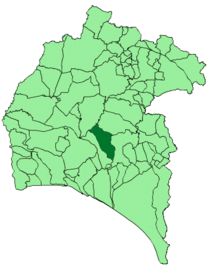Beas, Spain facts for kids
Quick facts for kids
Beas
|
|||
|---|---|---|---|
|
|||
| Country | Spain | ||
| Autonomous community | Andalusia | ||
| Province | Huelva | ||
| Area | |||
| • Total | 144.66 km2 (55.85 sq mi) | ||
| Elevation | 125 m (410 ft) | ||
| Population
(2018)
|
|||
| • Total | 4,236 | ||
| • Density | 29.282/km2 (75.841/sq mi) | ||
| Time zone | UTC+1 (CET) | ||
| • Summer (DST) | UTC+2 (CEST) | ||
| Website | www.aytobeas.es | ||
Beas is a small town, also known as a municipality, located in the province of Huelva in Spain. It's a place where people live, work, and go to school. In 2005, about 4,162 people called Beas home.
Contents
What is Beas?
Beas is a municipality, which is like a local government area. It's part of the larger Andalusia region in southern Spain. The town is known for its quiet charm and local traditions.
How Many People Live in Beas?
This section looks at the demographics of Beas. Demographics means studying how many people live in a place, how old they are, and other facts about them. The population of Beas has changed a bit over the years.
| Historical population | ||
|---|---|---|
| Year | Pop. | ±% |
| 1999 | 4,165 | — |
| 2000 | 4,124 | −1.0% |
| 2001 | 4,085 | −0.9% |
| 2002 | 4,023 | −1.5% |
| 2003 | 4,036 | +0.3% |
| 2004 | 4,139 | +2.6% |
| 2005 | 4,162 | +0.6% |
| 2011 | 4,353 | +4.6% |
As you can see from the numbers, the population has stayed around 4,000 to 4,300 people. This shows that Beas is a stable community.
Things to See in Beas
One important building in Beas is the Parish Church of St. San Bartolomé Apóstol. It's a historic church where people go for religious services.
Beas is also famous for its Living Nativity Scene. This is a special event where people dress up and act out the story of Christmas. It's a tradition that started in 1970 and is very important to the town. There's even a monument dedicated to it!
Where is Beas Located?
Beas is in the province of Huelva. This province is in the southwest part of Spain. It's close to the border with Portugal. The area is known for its beautiful landscapes and agricultural lands.
See also
 In Spanish: Beas para niños
In Spanish: Beas para niños







